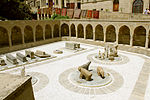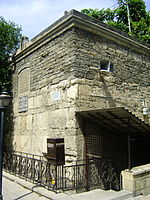Maiden Tower (Baku)

The Maiden Tower (Azerbaijani: Qız qalası; Persian: قلعه دختر) is a 12th-century monument in the Old City, Baku, Azerbaijan. Along with the Shirvanshahs' Palace, dated to the 15th century, it forms a group of historic monuments listed in 2001 under the UNESCO World Heritage List of Historical Monuments as cultural property, Category III. It is one of Azerbaijan's most distinctive national emblems, and is thus featured on Azerbaijani currency notes and official letterheads.The Maiden Tower houses a museum, which presents the story of the historic evolution of Baku city. It also has a gift shop. The view from the roof takes in the alleys and minarets of the Old City, the Baku Boulevard, the house of Isa bek Hajinski and a wide vista of the Baku Bay. The Tower is covered by cloud of mysteries and legends which are rooted to the history and culture of Azerbaijan. Indeed, some epics became a subject for scenario for ballets and theatre's plays. The Maiden Tower (ballet) is a world-class Azerbaijani ballet created by Afrasiyab Badalbeyli in 1940 and ballet's remake was performed in 1999. Consequent to the receding of the sea shoreline of the Caspian Sea, a strip of land emerged. This land was developed between the 9th and 15th centuries, when the walls of the old city, the palace including the huge bastion of the Maiden Tower were built.
Excerpt from the Wikipedia article Maiden Tower (Baku) (License: CC BY-SA 3.0, Authors, Images).Maiden Tower (Baku)
Aziz Aliyev street, Baku City
Geographical coordinates (GPS) Address Nearby Places Show on map
Geographical coordinates (GPS)
| Latitude | Longitude |
|---|---|
| N 40.3661 ° | E 49.8372 ° |
Address
İçəri şəhər
Aziz Aliyev street
1095 Baku City (Sabail Raion)
Baku, Azerbaijan
Open on Google Maps










